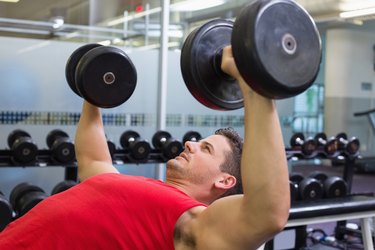
Strength training constitutes an important element of training for most athletes. The method of strength training an athlete uses, though, depends on the type of sport played and her particular goals. While athletes in general benefit from full body workouts, which build overall body strength and power, athletes will sometimes use an upper/lower body training split to achieve specific strength objectives.
Scheduling Your Workouts
Video of the Day
An upper/lower body split means you train these muscle groups on different days. For example, you might train your chest, arms and back on Mondays, train your legs, gluteals and abs on Tuesday, rest on Thursday, train your upper body again on Friday, and train your lower body again on Saturday. A full body workout means that you would do a strength-training routine that activates all your muscle groups on Monday, Wednesday and Friday -- leaving rest days between workouts.
Video of the Day
Advantages for Each
Training in a split workout allows you to train more often but still provide adequate rest for worked muscles. You can also spend more time and perform more exercises for one muscle group when you train in a split. You might be able to lift heavier weights on split days because your sessions may be shorter and you do not have to worry about excessive fatigue setting in before you get to other muscle groups.
Training the full body works your body in a synergistic way -- multiple muscle groups may be addressed in one singular move. In addition, training the full body in one session could provide you with more overall body strength. Full body training is also more expedient. You can train the same body parts three times per week in just three sessions. If you use a split, you would have to visit the gym six times per week to get the same number of visits for each body part.
Athlete Considerations
Upper/lower body splits might benefit athletes who have specific weaknesses in a muscle group. Certain types of athletes, such a bodybuilders whose goal is size and not performance, also benefit from upper/lower body splits, because it allows them to lift the heaviest weights possible during a session. For example, if you perform maximum lifts for your back and chest during a workout, you may lose stamina and enthusiasm to lift your heaviest for your legs later in the workout.
Full body workouts are of value for athletes whose sports demand power and agility. These allow you to train the body as a unit -- athlete's moves during competition are rarely performed in isolation. Full body workouts recruit more total muscle mass during each lifting session, which may also benefit athletes. Athletes who participate in multiple training sessions and practices per week may also perform total body workouts for expediency, as they do not have time to visit the weight room four to six times per week to train in splits.
Goal of Training
The goal of athletes is to become more efficient at their sport. All training should focus on power, strength, speed, agility, flexibility, body awareness, coordination, mental toughness and goal setting. While upper/lower body splits can help with some of these goals, incorporating total body workouts may hit more of these objectives in each session. For example, a total body workout might include moves, such as pushups, pullups and Olympic lifts, which train power, agility and strength all at once.